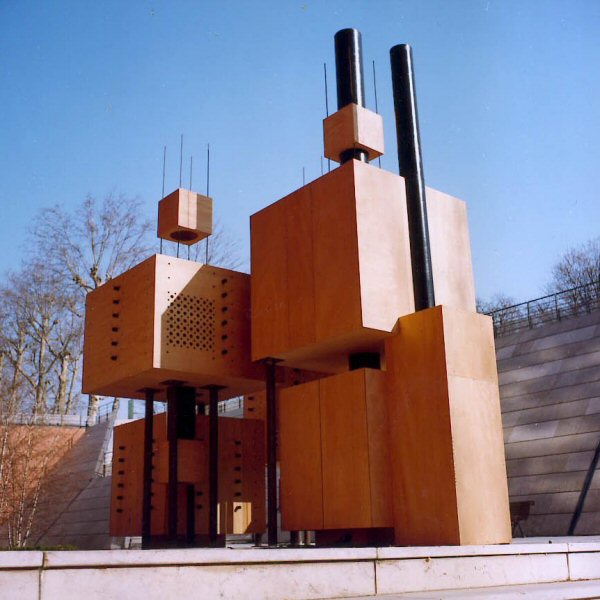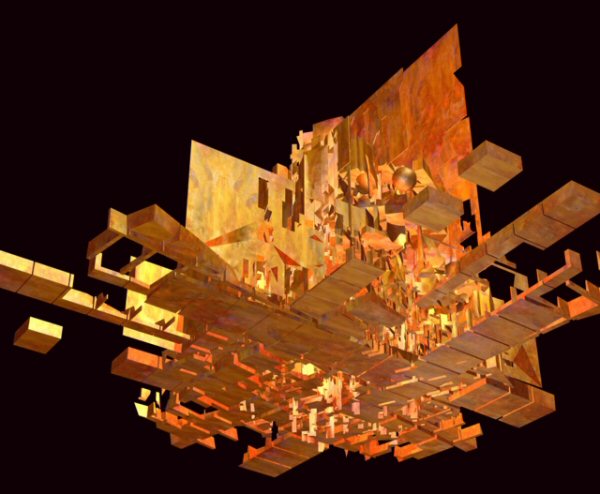Please wait a few moments while we process your request

Université du Québec à Montréal (UQAM)
Nicolas Reeves and the NXI GESTATIO Laboratory
Nicolas Reeves was born in 1957 in Ithaca, New York. The University of Montreal granted him a bachelor's degree in architecture in 1982 and a bachelor of physics degree in 1985. Reeves did graduate work in physics in Montreal until 1986 and then went on to obtain a master of science degree in architecture at the Massachusetts Institute of Technology in 1988. He now teaches in the department of design at the Université du Québec à Montréal (UQAM) and heads the university's NXI GESTATIO laboratory for research and creation in computer science, architecture and design.
Reeves worked with architects Philippe Madre (Paris) and Prix-de-Rome recipient Jacques Rousseau (Montreal) before being admitted to the Quebec board of architects in 1992. He also works as a volunteer designer and architect for non-profit organizations. Reeves won the Grand Prize of the Architecture Quebec Competition in 1994, has received many grants and awards from organizations such as the Canada Council for the Arts, and has lectured extensively around the world. He has published numerous articles on his work using stereolithographic devices and coding systems in journals such as ARQ - The Architecture Review et Inter.
Through the NXI GESTATIO laboratory at UQAM, Reeves has been creating architectural and meteorological sound sculptures. La Harpe à Nuages (1997-2000) is also known as the Keplerian Harp after German astronomer Johannes Kepler (1571-1630), who first came up with the term "music of the spheres" (1). Reeves describes the harp as a "meteo-electronic installation." It is a physical sculpture containing a technological system that, thanks to a series of infrared lasers, reads the structure of clouds and then transforms this reading into sound or music. The melodies or noise varies depending on factors such as altitude, cloud density and meteorological conditions. The system is very similar to the principles of compact disc technology, "in which a lens captures tiny laser-beam modulations, and a decoding system converts them into music or sound" (2).
The cloud harp was first demonstrated in Amos, Quebec, in 1997. Since this premiere, Reeves and the NXI GESTATIO team have been developing the technology for the harp. With the Daniel Langlois Foundation's financial support, they have created a bigger harp that uses seven string (as opposed to the original single string) This new version performed in March 2000 at the Musée d'art contemporain de Lyon as part of the Lyon Cité Sonore event.
Another project funded by the Foundation and developed in the NXI GESTATIO laboratory is titled Les Mutations de la Blanche Biche (Mutations of the White Doe). This is a series of architectonic sculptures called "computer architectones" and "surrational morphologies" (3).
"[The sculptures] are grown from the evolution of artificial life systems, using computer methods known as "cellular automata," "genetic algorithms," "neural networks." In such systems, which can be compared to virtual biocultures, a large number of numerical organisms live, evolve, crossbreed and die. Different kinds of organisms exist, each of them being characterized by a particular behaviour. Their social universe is governed by strictly deterministic rules: chance plays no role in the process." (4)
To date, Reeves and the NXI GESTATIO team have produced two mutations: Coireault (circa 1999) and Doncieux (circa 1999). Each of the structures emits a low-volume audio sequence based on a traditional song called The White Doe (La Blanche Biche). The sonic components of the architectones in this installation are generated using variations of the song coming from Denmark and Quebec. Les Mutations de la Blanche Biche was presented at the Centre d'exposition d'Amos from December 15, 2000, to January 21, 2001.
Reeves worked with architects Philippe Madre (Paris) and Prix-de-Rome recipient Jacques Rousseau (Montreal) before being admitted to the Quebec board of architects in 1992. He also works as a volunteer designer and architect for non-profit organizations. Reeves won the Grand Prize of the Architecture Quebec Competition in 1994, has received many grants and awards from organizations such as the Canada Council for the Arts, and has lectured extensively around the world. He has published numerous articles on his work using stereolithographic devices and coding systems in journals such as ARQ - The Architecture Review et Inter.
Through the NXI GESTATIO laboratory at UQAM, Reeves has been creating architectural and meteorological sound sculptures. La Harpe à Nuages (1997-2000) is also known as the Keplerian Harp after German astronomer Johannes Kepler (1571-1630), who first came up with the term "music of the spheres" (1). Reeves describes the harp as a "meteo-electronic installation." It is a physical sculpture containing a technological system that, thanks to a series of infrared lasers, reads the structure of clouds and then transforms this reading into sound or music. The melodies or noise varies depending on factors such as altitude, cloud density and meteorological conditions. The system is very similar to the principles of compact disc technology, "in which a lens captures tiny laser-beam modulations, and a decoding system converts them into music or sound" (2).
The cloud harp was first demonstrated in Amos, Quebec, in 1997. Since this premiere, Reeves and the NXI GESTATIO team have been developing the technology for the harp. With the Daniel Langlois Foundation's financial support, they have created a bigger harp that uses seven string (as opposed to the original single string) This new version performed in March 2000 at the Musée d'art contemporain de Lyon as part of the Lyon Cité Sonore event.
Another project funded by the Foundation and developed in the NXI GESTATIO laboratory is titled Les Mutations de la Blanche Biche (Mutations of the White Doe). This is a series of architectonic sculptures called "computer architectones" and "surrational morphologies" (3).
"[The sculptures] are grown from the evolution of artificial life systems, using computer methods known as "cellular automata," "genetic algorithms," "neural networks." In such systems, which can be compared to virtual biocultures, a large number of numerical organisms live, evolve, crossbreed and die. Different kinds of organisms exist, each of them being characterized by a particular behaviour. Their social universe is governed by strictly deterministic rules: chance plays no role in the process." (4)
To date, Reeves and the NXI GESTATIO team have produced two mutations: Coireault (circa 1999) and Doncieux (circa 1999). Each of the structures emits a low-volume audio sequence based on a traditional song called The White Doe (La Blanche Biche). The sonic components of the architectones in this installation are generated using variations of the song coming from Denmark and Quebec. Les Mutations de la Blanche Biche was presented at the Centre d'exposition d'Amos from December 15, 2000, to January 21, 2001.
Angela Plohman © 2000 FDL
External links:
Nicolas Reeves:
http://www.designuqam.com/enseignants/
http://www.designuqam.com/enseignants/
Laboratoire NXI GESTATIO, École de Design de l'Université du Québec à Montréal:
http://www.nxigestatio.org/
http://www.nxigestatio.org/









